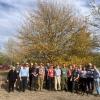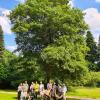Editor's Picks
Plant Focus
An Oak Study Day was held on July 21, 2023 at Chevithorne Barton, one of only three UK National Collections accredited by Plant Heritage. Hosted by the International Dendrology Society, the event was kindly opened to IOS members, and several came from within the UK and even from the US to participate. Around 40 people attended the Study Day—which was fortunately dry! Prior to the formal start of the program, we had the chance to meet fellow visitors over coffee and I quickly found out I was conversing with people with very varied interests and backgrounds.
As a non-dendrologist, arborist, or any other type of “-ist”, I was surprised at the number of private landowners present. Owning from 3 to 300 acres, they used their land to further their love of oaks from around the world. I found it very heartening to see that the smaller landowners in the UK were playing their part in re-populating the land with hardwood trees, albeit not all native.

Chevithorne Barton is a late Elizabethan manor house deep in the Devonshire (UK) countryside covering approximately 40 acres, with a collection of 787 oaks. The current house was built in 1610 and had been bought by Sir John Heathcoat Amory in 1905. The garden was an important part of the family plans for the house from the moment they bought it. Michael Heathcoat Amory (1941-2016) inherited Chevithorne Barton from his grandmother May, who spent numerous years designing and laying out the beautiful gardens that we see today.
Chevithorne Barton is rather damp by southern England standards with rainfall of about 890 mm a year. Snow and late frosts are not uncommon. Careful planting has reduced damage to the newly planted oaks; many of them tend to put on growth early in the spring or late in the autumn and are therefore more susceptible to subsequent cold winters. Michael started planting the oaks we see today in 1985. At present, many of the oaks are still small, but in fifty years’ time the garden and surrounding landscape at Chevithorne will have changed profoundly. The oaks grow at different speeds, sometimes faster and sometimes slower than in their countries of origin. A traditional English oak will still take more than a hundred years to reach maturity, but some of the American oaks will be mature in less than fifty years. A few of the Mexican oaks are currently growing as fast as bamboos, between 1-2 meters a year, but for how long is not known, and it may leave them weak and unable to withstand the strong winds that seem to be becoming more frequent.

The combination of relatively warm winters, reasonably high rainfall, and strong, deep, loamy soil seems to suit the diverse range of oaks that are being planted. Climate change may well play a part in the future plans for Chevithorne although whether it will have warmer weather, or merely more variable and extreme conditions, remains to be seen.
What was interesting to me was the variety of oaks we saw. Whatever happens, it is hoped that Chevithorne Barton’s oak collection will prosper for many years to come.

The visitors were welcomed by the owner of Chevithorne since 2018, Edward (Ed) Amory, who spoke of the background to both the extensive formal garden and his father’s initiative to begin what is now an extensive collection of oaks. For the future Ed is looking at ways of integrating the formal gardens and the vast collection of oaks from around the world that are admired by all lovers of oak trees.
The formal part of the day started with Roderick Cameron, the IOS President, giving a fascinating talk on the genus Quercus. The key part of the presentation covered oak systematics. Whilst my brain was able absorb a deal of it, I must admit that due to my lack of basic knowledge of Quercus much went over my head. Having said that I received a copy of Roderick’s presentation after the event and re-reading it helped me to understand much more.

After splitting into two groups, the one I was in was led by James McEwen, the Curator of the oak collection, and Roderick Cameron. My head was dizzy from the knowledge of the different and numerous oaks that James discussed. Between them James and Roderick were able to answer all the questions put to them. For my part, my eyes and ears took in numerous other natural phenomena, white marble butterflies which have returned to the meadow since the grass was kept uncut, and the sharp cry of a pair of red kites caught my attention as they circled overhead. Both demonstrated the diversity of wildlife at Chevithorne.
After lunch Greg Watson, Head Gardener at Chevithorne, gave a talk on the conservation work being carried out in the collection and the propagation techniques he is using to root rare oaks from cuttings. This was followed by a continuation of the morning tours of the oak trees at Chevithorne.

My visit to Chevithorne Barton was one way to prove to fellow woodturners that I don’t only love horizontal trees. Oak trees are very interesting in the vertical position too! For my part the Oak Study Day was an eye-opener to another world. One that is obviously shared by people who are interested in oaks not just for the science, but for what they are: beautiful, majestic trees.
A detailed report of the Oak Study Day will be published in International Oaks No. 35 in May 2024.
1 Editor's note: The author's sense of humor matches his woodturning skill. The "acorn" is well worth a closer look. It is fashioned from over a dozen different types of wood of contrasting colors and grains, including walnut (Juglans regia), English oak (Q. robur), boxwood (Buxus sempervirens), purple heart (Peltogyne sp.), African blackwood (Dalbergia melanoxylon), Indian rosewood (Dalbergia latifolia), beech (Fagus sylvatica), Olive (Olea europaea), she-oak (Casuarina sp.), and stabilized dyed box elder burl (Acer negundo). Here's a close up of both sides of the piece:

If you would like to acquire one of Chris West's acorns, or another of his pieces, click here to contact him.















